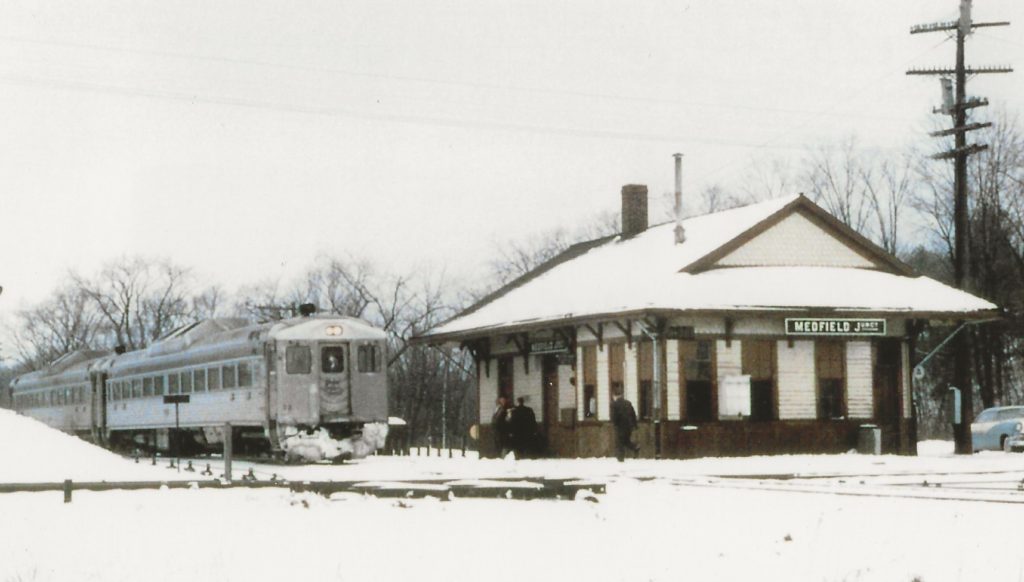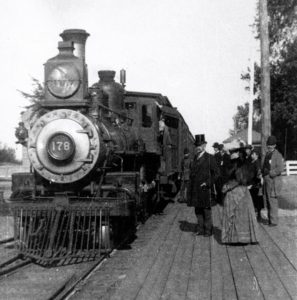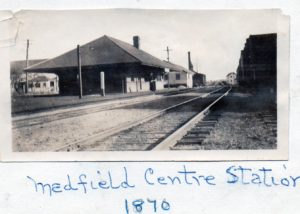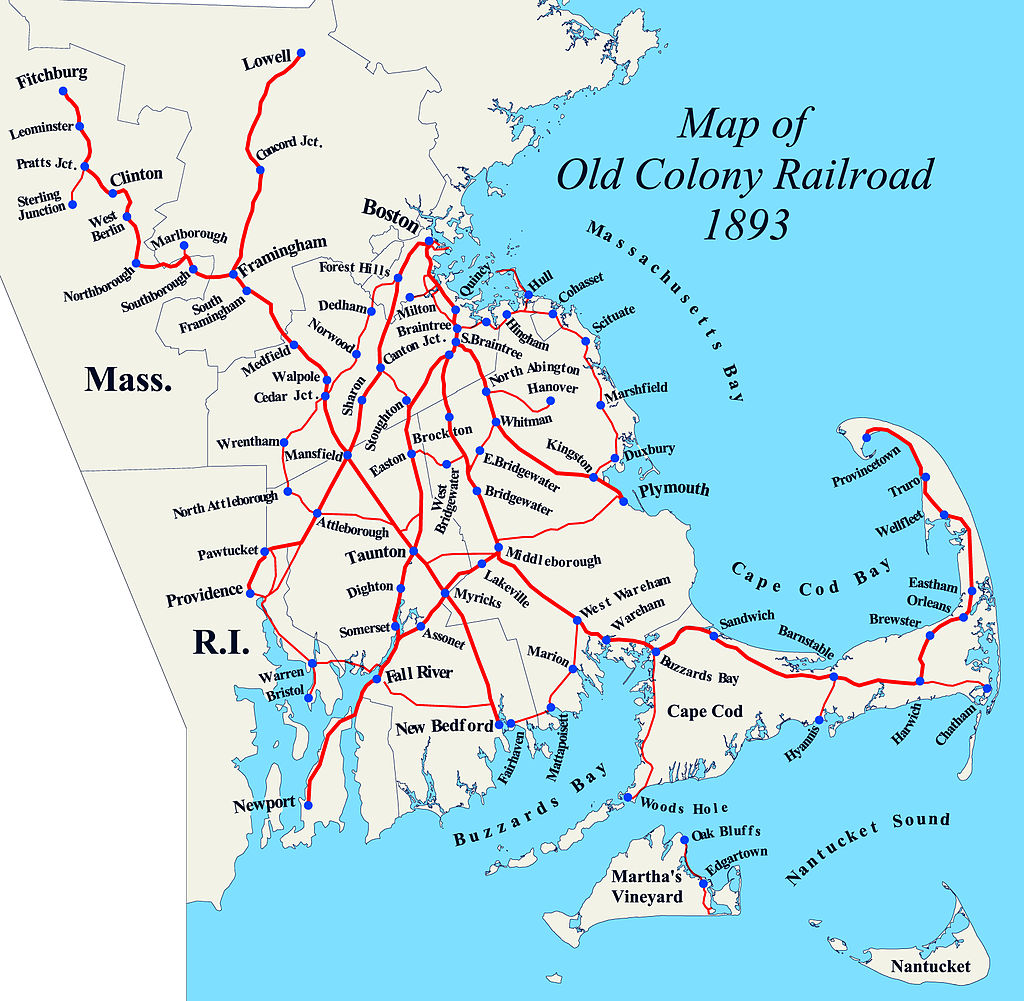Sept 1, 2022
If you Google “railroad enthusiasts” you get 39 million hits! Organizations for railroad enthusiasts, 8.6 million!

Marc Pizzuto is one such enthusiast. He has a room full of railroad memorabilia in his Norwood home. He recently came to visit the Medfield Historical Society to conduct some research and share stories and pictures about railroading.
Marc also brought two publications which provided much of the historical information in this article – a 40-page historical brochure, Bay Colony Railroad Excursions, by J. Leonard Bachelder of the Massachusetts Bay Railroad Enthusiasts, Inc., and a 13-page article, The Charles River Line, by C. A. Brown, which appeared in Shoreliner, a publication of the New Haven Railroad Historical and Technical Association. Other information in this article came from Wikipedia articles.
—
For decades, Medfield residents and other drivers on Route 109 have been accustomed to sporadic interruptions as freight trains rumble through the crossing between Park and Spring Streets. But for a century, trains were a Big Thing, before they succumbed to the automobile.
The first railroad in Massachusetts went into operation May 16, 1834, connecting Boston to Newton with three daily trains. Construction continued westward, and the first train steamed into Worcester in June 1835. In that decade rails were laid to connect Boston to Lowell and Providence.
In 1852 service began on a new branch connecting Newton with Needham, and a charter was issued for the Charles River Railroad to build a line from Dover to Bellingham.
Service connecting Medfield to Boston, via Needham, began November 18, 1861. The service stopped and resumed several times, but it stopped for good April 21, 1967.
The Medfield Junction station was at the intersection of Adams and West Mill Streets, at the crossing of the two railroad lines.

The winter scene at Medfield Junction was shot in the late 1950s – the parked car barely in the photo is a 1956 Ford. On the tracks are two Budd RDC-1 cars, joined together. Each car could hold 90 passengers and is self-powered with its own diesel engine; they were intended to provide rail service for passengers on less-traveled routes. The fare from Medfield to Boston was $1.16 in 1965.
In 1867, the Mansfield and Framingham Railroad opened on a perpendicular route, crossing the Charles River Railroad line at Medfield Junction and opening its own station closer to the center of Medfield. Passenger service on this line ended in 1933.


Filling in Back Bay
In the late 1850s the separate Charles River Branch Railroad made it possible to fill in 700 acres of Boston’s Back Bay. In Needham, two new steam shovels were put to work leveling 100 acres of hills near the river and loading gravel onto railroad cars. Over several decades trains ran hourly, each carrying 150 cubic yards.
Early Railroad Technology and Safety
In those early days, passenger trains provided faster and smoother…but probably riskier…transit than horse-drawn coaches over the rudimentary roads of that era. But today, the death rate is 20 times higher for people riding in automobiles than on a train.
The first, horse-drawn railroads used wooden rails, which, unsurprisingly, wore out quickly. Cast iron was used in the early 19th century but was supplanted by steel, which was introduced in 1857. Individual rail pieces were 15 feet long for much of the 19th century and were fastened together on wooden ties. In 1924 the first continuously-welded rail was used; it’s safer, smoother-riding, and requires less maintenance, and it is standard everywhere today.
A critical railroad safety device was invented in 1869 – the Westinghouse air brake, in which air pressure was used to keep the brakes disengaged. If the brake line was broken…as would happen if, for example, a car became separated…the pressure would be lost, and the brakes would automatically be applied.
In 1876, the Ashtabula River railroad disaster in Ohio, which claimed 92 lives and injured 64 more, led to major changes in bridge construction codes and mandatory federal investigation of railroad disasters.
—
As happens today with new technologies, railroad companies sprang up and folded or were bought out left and right. An exception of sorts was the Old Colony Railroad, initially chartered in 1838. It ran until 1893, when the New York, New Haven, and Hartford got a 99-year lease on all its lines. The New Haven, as it was popularly called, lasted until the 1960s and was ultimately folded into Conrail. This 1893 map of the Old Colony network illustrates in part how at the time, Massachusetts had the greatest railroad density of any state…or other country.

Timeline of Some Significant Transportation Developments
Most of the major developments relating to transportation have occurred in the last 200 years. But here’s a list going back to the very beginning.
8,000 BCE – Pesse canoe, Netherlands – oldest recovered boat (earlier boats are thought to have been used up to 1,000,000 years ago).
4,800 BCE – horse domesticated (dogs were domesticated 30,000 years ago; goats and chickens 10,000 years ago).
4,000 BCE – first sailboat (in Egypt).
3,500 BCE – solid wheel (first used for making pottery, then used with axle to make two-wheeled cart)
2,000 BCE – spoked wheel
1712 – steam engine invented by Thomas Newcomen to pump water out of mines; significantly improved 1764 by James Watt.
1769 – Fardier à vapeur, steam-powered three-wheel road vehicle used to transport artillery invented by Nicholas-Joseph Cugnot.
1790s – early iron railways in England
1804 — First railroad steam locomotive, first steamboat
1816 – Laufmaschine, a steerable but pedal-less bicycle
1830 – first American railroad – Baltimore and Ohio
1860s – steel supplants iron in tracks; first transcontinental railroad
1861 – Charles River Railroad service comes to Medfield!
1866 – first steam-powered road wagon, by Richard Dudgeon of New York
1886 – cars powered by internal-combustion engine introduced by Daimler and by Benz
1888 – first bicycle, steerable with pedals, chain, and equal-size wheels
1898-1924 – Trolley service on Route 109 connects Medfield to Dedham and Medway